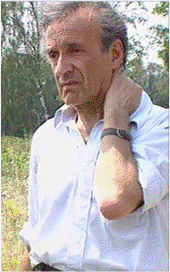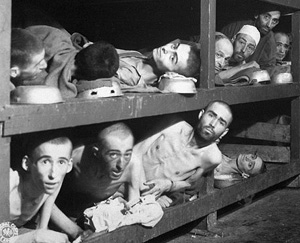New website to challenge Elie Wiesel on Auschwitz tattoo and identity
By Carolyn Yeager, July 2010
This article was written for the Smith Report newsletter to announce the new website Elie Wiesel Cons the World.
I Con the World
Is Elie Wiesel an icon or an “I con?”
 Wiesel has conned the world into seeing him as the next best thing to God, as someone who has risen above it all, as someone who is capable or has earned the right to pass judgment on the rest of humanity. What has earned him this right is clearly his suffering during the year he was held in German camps and his “powerful prose” in describing it.
Wiesel has conned the world into seeing him as the next best thing to God, as someone who has risen above it all, as someone who is capable or has earned the right to pass judgment on the rest of humanity. What has earned him this right is clearly his suffering during the year he was held in German camps and his “powerful prose” in describing it.
Venerated and billed as “the world’s most famous Holocaust survivor” and a Nobel Peace Prize Laureate, earning hundreds of thousands of dollars every year in speaking fees (at $25,000 a pop it might be closer to say a million), and holding a prestigious, but undemanding six-figure professorship in Humanities at Boston University, Elie Wiesel has never been asked to show any proof that he is what he says he is.
Everything written about Elie Wiesel that this writer can find skims over the details and dwells on the emotionality of Holocaust, humanity and hate. Among the many unnerving quotations from Elie concerning the h-word is this one, found preceding an essay in the Jewish Daily Forward of June 9th by Anita Epstein, titled “Why I Cannot Forgive Germany:” (1)
“I cannot and I do not want to forgive the killers of children; I ask God not to forgive.”
—Elie Wiesel
Ms. Epstein is influenced (or inspired?) by Wiesel to hold onto hate by holding on to the holocaust legends, such as the one about “Germans” throwing babies off of balconies. Another famous statement made by Elie is:
“Every Jew, somewhere in his being, should set apart a zone of hate – healthy virile hate – for what the German personifies and for what persists in the German. To do otherwise would be a betrayal of the dead.”
However, Elie’s actual presence in the Auschwitz “death camp” and the Buchenwald concentration camp during 1944-45 rests solely on the claims of the New York Times and his well-promoted books, the most famous being his first one, Night, published in 1955 in Buenos Aires. That’s an interesting story in itself, but here I will limit myself to a chronology of NYT features on Elie that coincide with his advancing fortunes.
On May 6, 1945, the New York Times published the now famous photograph of the “Crowded Bunks in the Prison Camp at Buchenwald” without identifying anyone in the picture. Further use of the picture follows.

October 1983, it was published again in the high circulation Sunday NYT Magazine with this caption: “On April 11, 1945, American troops liberated the concentration camp’s survivors, including Elie, who later identified himself as the man circled in the photo.”(2) (Wiesel says he is the last one on top row in this cropped version of the picture)

Wiesel had never claimed to be in this picture before, and this face is not the face of a 16-year-old boy, nor does it resemble an existing portrait of Elie before he was deported. But, the article included the statement: “His name has been frequently mentioned as a possible recipient of a Nobel Prize, for either peace or literature.” So we suspect it was part of the campaign being waged to win him a Nobel Prize.
As David O’Connell has written in “Elie Wiesel and the Catholics,”(3) the NYT had manufactured history by declaring erroneously that Wiesel is seen in the picture, even though Wiesel had stated over the years that he was in the sick bay at Buchenwald on April 16, the day the photograph was taken.
October 14, 1986. The Nobel award was announced.
November 2, 1986. The NYTimes again republished a severely cropped version of the Buchenwald photo with the caption: “Elie Wiesel, the winner of the Nobel Peace Prize (at far right in the top bunk) in the Buchenwald concentration camp in April 1945, when the camp was liberated by American troops.” (4)
January 4, 1987. The NYT erroneously claimed that Wiesel had been “freed from Auschwitz” during the war. (5)
January 18, 1988. The NYT wrote on the occasion of his trip to Auschwitz: “Mr. Wiesel was a prisoner at Auschwitz and witnessed the killing there of his father and one of his sisters.” (6) But, according to Wiesel’s account (no records), his father died in Buchenwald. However, the NYT knew that Auschwitz was a familiar Holocaust “keyword” to its readers, while Buchenwald was not.
More confusion:
June 3, 1987, the Chicago Tribune published a photo of Wiesel, accompanied by two other men, standing in front of a blown-up version of the picture and pointing to himself in it. The caption read: “Nobel Prize winner Elie Wiesel points to a picture of himself, taken by a German at the Auschwitz death camp in 1945. The photograph is part of the Holocaust Memorial in Lyon, France.”(7)
April 21, 1995, Wiesel told the German weekly Die Zeit that the picture had actually been taken the day after the liberation, that is, on April 12, 1945, not on April 11, as he had always implied. (It was actually taken on April 16.) He also said, “On the day after the liberation the picture was taken in the Children’s Block at Buchenwald by an American soldier. It shows old men. But these old faces are the faces of men who, in truth, were 15 or 16 years of age like I was.” (8)
There is much more to the story of this photograph, but that must be sufficient for now.
Counter Claims
In March 2009, fellow Hungarian Jew Miklos (Nikolaus) Grüner’s accusation that Elie Wiesel is an imposter broke onto the Internet, mainly via an article(9) on Henry Makow’s website that he picked up from a Hungarian website.(10) Naturally, it didn’t get much coverage in the media, even though Grüner had documents from both Auschwitz and Buchenwald to back him up, including undisputed records that show him registered as a prisoner in both camps. Back in January 2003, Grüner had issued an “international press release to the world” from his home in Sweden:
Elie Wiesel A-7713 has never existed, and the man claiming himself to be “Elie Wiesel” with the concentration camp number A-7713, knowing full well that this number belonged to someone else, is an imposter of the worst kind. For this statement, I, Nikolaus Grüner A-11104, have certified and written knowledge of. (11)

In a press release of 2006, Grüner states: “I […] take full responsibility in revealing that the 1986 Nobel Peace Prize winner “ELIE WIESEL” has been impersonating Lazar Wiesel A-7713 who was born 1913 in Marmaros, Hungary. Further more I also state that the archives in Auschwitz and Buchenwald are missing evidence to prove that “ELIE,” known as A-7713, was ever registered as a prisoner in any German concentration camp at all.” (12)
The evidence Grüner presents is compelling, and can be found in an organized fashion in two articles written by Carlo Mattogno and posted at Inconvenient History Revisionist Blog (13) on Feb. 24 and March 26 of this year. One small piece of this evidence is that Elie Wiesel was born on Sept. 30, 1928, and another is that the ID number A-7713 was given out on 24 May, but Elie Wiesel says in his book Night that he wasn’t deported from Sighet (Marmaros) until after May 28, and possibly not until June 3, 1944.
But the most persuasive evidence to me is registration cards and other official documents from the Auschwitz Museum archives that show Lazar Wiesel, b. Sept. 4, 1913 received number (and tattoo) A-7713 and his brother, Abraham, b. Oct. 10, 1900 was given A-7712.
A-7712 is the number Elie claims belonged to his father Shlomo, who was with him. There are no such registration records for Elie and his father.
The situation at Buchenwald is similar and the evidence against Elie Wiesel being a survivor of Auschwitz and Buchenwald at all continues to build to a veritable mountain, all of which will be graphically presented and archived at a website that is now under construction and soon to open.
Where’s the tattoo?
Our new website will carry the theme “Where’s the tattoo?” – an idea originally suggested by a poster on the CODOH forum. We present this to viewers as a world-wide challenge and to encourage investigation and demand for answers. We will ask for independent efforts by diverse groups to work with film, Youtube videos, petitions and letter-writing campaigns to Universities, especially Elie’s employer, Boston University.
We will challenge those in the “mighty mainstream media” to force attention on this issue. Everyone—you—can act as an individual entrepreneur, make use of the information we will provide, contribute information to I Con The World, coordinate with us. Our spotlight on Elie Wiesel and the issue of who he really is will be intense and unrelenting. We are not talking about speaking in riddles here, but of evidence that is in-your-face … or in-his-face. We urge your participation, we urge you to recruit others by bringing I Con The World to their attention, by encouraging others to contribute in whatever way they can.
Watch for us. Get ready to help.
Endnotes:
1) Jewish Daily Forward, June 9, 2010. http://forward.com/articles/128652/
2) Samuel G. Freedman, “Bearing Witness: The Life and Work of Elie Wiesel,” NYT, October 23, 1983.
3) “Elie Wiesel and the Catholics,” Culture Wars, November 2004.
4) Martin Suskind, “A Voice from Bonn: History Cannot be Shrugged Off,” NYT, November 2, 1986.
5) “A Survivor’s Prize,” NYT, January 4, 1987.
6) “Wiesel and Walesa Visit Auschwitz,” NYT, January 18, 1988.
7) “Elie Wiesel and the Catholics,” ibid.
8) “1945 und Heute: Holocaust,” Die Zeit, April 21, 1995.
9) http://www.henrymakow.com/translated_from_the_hungarian.html
10) http://kuruc.info/r/6/36390/
11) Nikolaus Grüner, Stolen Identity, Stockholm, 2005-06
12) Grüner, ibid.
13) http://www.revblog.codoh.com
Category
Elie Wiesel- Printer-friendly version
- 16984 reads









